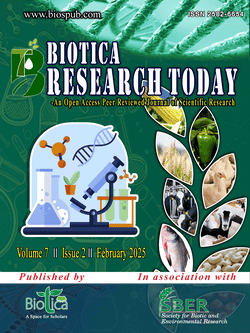
Anthracnose-Twister Complex: An Emerging Disease of Onion in India
Jayalakshmi K.*
ICAR-Directorate of Onion and Garlic Research, Pune, Maharashtra (410 505), India
Ram Dutta
ICAR-Directorate of Onion and Garlic Research, Pune, Maharashtra (410 505), India
Pranjali V. Bhadane
ICAR-Directorate of Onion and Garlic Research, Pune, Maharashtra (410 505), India
Priya Y. Gawande
ICAR-Directorate of Onion and Garlic Research, Pune, Maharashtra (410 505), India
Vinay Kumar
ICAR-Directorate of Onion and Garlic Research, Pune, Maharashtra (410 505), India
Komal Khandekar
ICAR-Directorate of Onion and Garlic Research, Pune, Maharashtra (410 505), India
Vishal S. Gurav
ICAR-Directorate of Onion and Garlic Research, Pune, Maharashtra (410 505), India
DOI: https://doi.org/10.54083/BRT/7.2.2025/38-40
Keywords: Anthracnose-twister, Favourable conditions, Integrated disease management, Onion
Abstract
Onion (Allium cepa L.) is most profitable spice-vegetable crop in India, but it is susceptible various fungal, bacterial, viral and nematode diseases which affects bulb production. Among several fungal diseases anthracnose and anthracnose-twister complex are the major destructive diseases incited by Colletotrichum gleosporioides and Fusarium moniliformis in all cropping seasons particularly kharif onion leads 80% yield losses in field which causes shortage of onion in the market as a result there will be increase in the onion price. So ultimately famers rely on chemicals to manage the disease which raise the production costs and cause problems for the environment and human health. This article's emphasis on symptomatic diagnosis, favourable factors that led to the epidemic of the disease and integrated management strategies to tackle the threat will be extremely helpful to onion growers, students, extension workers and other onion researchers.
Downloads
not found
Reference
Alberto, R.T., Perez, P.M., 2020. Development of integrated disease management program against Anthracnose-Twister (Colletotrichum gloeosporioides-Gibberella moniliformis) disease of onion (Allium cepa). Plant Pathology and Quarantine 10(1), 111-119. DOI: https://doi.org/10.5943/PPQ/10/1/13.
Chowdappa, P., Chethana, C.S., Pavani, K.V., 2015. Colletotrichum siamense and C. truncatum are responsible for severe outbreaks of anthracnose on onion in southwest India. Journal of Plant Pathology 97(1), 77-86. URL: https://www.jstor.org/stable/24579133.
Dutta, R., Jayalakshmi, K., Nadig, S.M., Manjunathagowda, D.C., Gurav, V.S., Singh, M., 2022. Anthracnose of onion (Allium cepa L.): A twister disease. Pathogens 11(8), 884. DOI: https://doi.org/10.3390/pathogens11080884.
Dutta, R., Jayalakshmi, K., Kumar, S., Radhakrishna, A., Manjunathagowda, D.C., Sharath, M.N., Gurav, V.S., Mahajan, V., 2024. Insights into the cumulative effect of Colletotrichum gloeosporioides and Fusarium acutatum causing anthracnose-twister disease complex of onion. Scientific Reports 14, 9374. DOI: https://doi.org/10.1038/s41598-024-59822-w.
Ebenebe, A.C., 1980. Onion twister disease caused by Glomerella cingulata in northern Nigeria. Plant Disease 64(11), 1030-1032. DOI: https://doi.org/10.1094/PD-64-1030.
